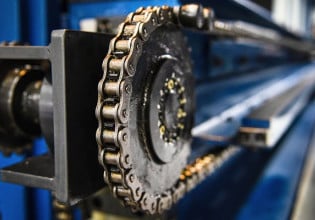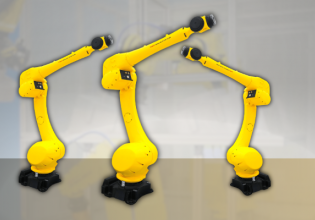SCHUNK Creates New, Innovative Pneumatic Positioning Solution
Pneumatic grippers are traditionally limited to fully open or closed positions, making SCHUNK’s Pneumatic Positioning Device useful for applications requiring an intermediate grip position.
Free pneumatic positioning is a concept that solves some obstacles presented by traditional air-actuated linear motion, where a pressure or position sensor detects the cylinder position only at (or close to) its fully extended and retracted position. Electric grippers can provide finite position control, but what happens when the two benefits must be combined: precise motion control, but using air as a power source? This is the challenge solved by free pneumatic positioning.
This type of system is often used in applications where gripping flexibility is necessary. Some scenarios that may require free pneumatic positioning include solutions where a single gripper is used to handle multiple types of product in close proximity to each other, or in situations where the pneumatic gripper operates in tight quarters and collision is a possibility. These types of solutions are often complicated and require multiple tool switch operations to be integrated into the desired process.

SCHUNK offers a complete solution for free positioning, gripping force, and speed adjustment on pneumatic grippers. Image used courtesy of SCHUNK
Pneumatic Positioning Device (PPD) from SCHUNK
SCHUNK, an international technology company, has recently developed a new type of pneumatic positioning device (PPD), for flexible gripping solutions. The solution comes as a complete setup, including the gripper, sensor, and positioning device all in one to help simplify the process.
In the past, such solutions came as separate entities(often from different manufacturers) and constituted a more complicated integration for end users. SHUNK hopes to circumvent this with a complete solution that helps to simplify the introduction of a pneumatic positioning device into a variety of plant processes.
Features of the PPD
Commissioning of the new solution is also easier with the use of prefabricated PLC function blocks, reducing the amount of time necessary for the onboarding process. The PPD looks to be an effective solution for users who need greater gripper flexibility, tight quarter gripping, and different workpiece size gripping capabilities.
The technology was developed as an accessory for current gripping solutions and is controlled via an IO-Link connection. When used in conjunction with a position sensor, any intermediate gripper position becomes a possibility. This can be a huge advantage in applications where a half-grip position is beneficial. The solution helps to overcome the traditional dual position gripping limitations: gripper open or gripper closed. The ability to precisely move a pneumatic gripper opens a whole new field of possibilities for part handling.

Close-quarters gripping is made easier with gripper prepositioning helping to avoid gripper-product collisions. Image used courtesy of SCHUNK
The solution includes a standard gripper in conjunction with the PPD and position sensor, so the device can easily be added to any existing equipment already using a standard pneumatic gripper. Users can easily retrofit existing processes keeping the downtime to a bare minimum.
Cycle Time Reduction
Process cycle times can also be reduced with the use of the PPD since the gripper no longer has to pause to reach the extremes of its gripping range before being moved into gripping position. In addition, collisions with closely placed workpieces can be avoided since the PPD prepositions the gripper before it is moved into place.
Grip Pressure Regulation
Gripping pressure can also be closely regulated and adjusted by changing the output pressure from the controller. This offers clear advantages in processes that require a more gentle force to prevent product damage. Gripping speed can also be controlled to help further lighten the amount of force exerted by the griper in delicate applications.
The design is rated IP 67 and features a sealed design suitable for industrial environments and can even be placed directly on the end of the robotic arm. End of arm mounting reduces the amount of hose needed for successful integration.
Three different flow rates are available but the weight and physical design of the device remain the same regardless of the flow rate. Accuracy of up to 0.5 mm is possible for precision positioning.






